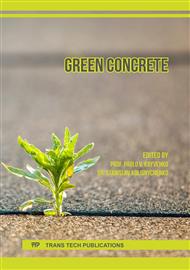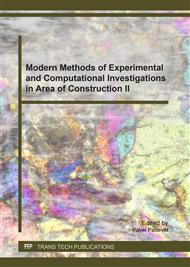[1]
R. Schnidt, P. A. Fast, High volume fly ash concrete usage for skytrain stations, Technical report, (2000).
Google Scholar
[2]
J. Keil, Výstavba vodního díla Orlík - sborník statí, NP Vodní stavby, Prague, 1966 (in Czech).
Google Scholar
[3]
Information on http: /www. pvl. cz.
Google Scholar
[4]
O. Zobal, V. Šmilauer, L. Kopecký, et al., Analysis of concrete from the body of the Orlik dam after fifty years, In: Beton - technologie, konstrukce, sanace, 02/2014, pp.19-25. ISSN 1213- 3116.
Google Scholar
[5]
O P Cirkle and O. Pospíchal: New way of frost resistance determination of concrete by using methods for structural damage monitoring, In: Beton - technologie, konstrukce, sanace, 03/2011, pp.56-61. ISSN 1213-3116.
Google Scholar
[6]
Information on http: /stavba. tzb-info. cz/podlahy/9370-diagnostika-trhlin-v-prumyslovychvsypovych-betonovych-podlahach.
Google Scholar
[7]
K. Valíková, Atmosférická koroze historických betonových staveb, Bachelor thesis, Masaryk University, Brno, 2010 (in Czech).
Google Scholar
[8]
M. Chromá, Studium a model karbonatace betonu, PhD thesis, University of Technology, Brno, 2012 (in Czech).
Google Scholar
[9]
W. Berg, et al., Příručka - Popílek v betonu - základy výroby a použití. ČEZ Energetické produkty, s. r. o., pp.81-86, Prague, 2013 (in Czech).
Google Scholar
[10]
ČSN EN 73 2154: Determination of carbonation depth in hardened concrete by the phenolphthalein method, Prague, 2008 (in Czech).
Google Scholar
[11]
ČSN 73 1322: Determination of frost resistance of concrete, Prague, 1969 (in Czech).
Google Scholar
[12]
F. Tian, W. X. Hu, H. M. Cheng, Y. L. Sun, Carbonation Depth of Recycled Aggregate Concrete Incorporating Fly Ash, Advanced Materials Research, Vols. 261-263, pp.217-222, (2011).
DOI: 10.4028/www.scientific.net/amr.261-263.217
Google Scholar
[13]
R. Reis, R. Malheiro, A. Camões, M. Ribeiro, Carbonation Resistance of High Volume Fly Ash Concrete, Key Engineering Materials, Vol. 634, pp.288-299, (2015).
DOI: 10.4028/www.scientific.net/kem.634.288
Google Scholar
[14]
X. S. Zhang, Study on Carbonation Resistance of High-Performance Concrete with Large Amount of Fly Ash, Advanced Materials Research, Vols. 476-478, pp.1688-1691, (2012).
DOI: 10.4028/www.scientific.net/amr.476-478.1688
Google Scholar
[15]
A. M. Neville. Properties of concrete. 2009. New York. pp.503-505. ISBN 0-582-23070-5.
Google Scholar
[16]
Information on http: /www. nebeske. cz/ - Jiří Jiroušek.
Google Scholar
[17]
Photo Documentation of construction.
Google Scholar



